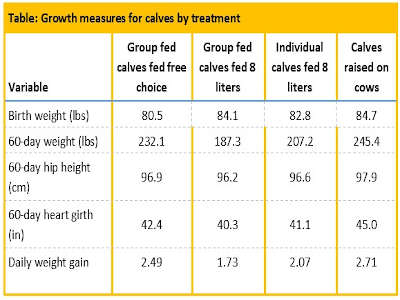By Brad Heins
Most organic dairy producers in the US use individual housing methods to raise dairy calves, meaning each calf has their own pen for the first several weeks of life. In a new research project at the West Central Research and Outreach Center (WCROC) in Morris, we are raising calves on cows in our dairy system as one of the experimental treatments.
The WCROC was recently awarded three grants totaling $2.1 million through the USDA National Institute of Food and Agriculture to further research in the areas of pre-weaned calf rearing options, disbudding alternatives for organic dairy calves, and the effect of high-legume diets on milk quality. For the project on calf rearing options, Brad Heins and Marcia Endres will compare individual housing, group housing, pair housing, and raising calves with cows on pasture in the context of calf health, behavior and welfare. Ultimately, the team will provide recommendations on best calf rearing options for organic dairy producers.
The overarching goal of the calf rearing project is to identify the best calf housing option to enhance positive calf welfare. The results will help improve the long-term profitability and social sustainability of the dairy industry by improving its public image. Through this project, we will provide recommendations on best calf rearing options for organic dairy producers to implement based on welfare outcomes, health benchmarks, and management feasibility. The dairy industry must improve calf rearing methods to balance health and animal welfare to meet the demands of stakeholders, as well as consumers.
During the spring of 2020, we started a small pilot study to evaluate calves raised on cows on pasture compared to calves raised in individual pens or calves raised in groups on an automated calf feeder. For the study, there were 15 group-fed calves, 16 individual calves, and 14 calves raised on cows. Growth data for calves to 60 days of age are shown in the Table. For all groups, calves were weekly weighed and scored for health, body condition and behavioral measurements.

At 60 days of age, the calves raised on cows had greater body weight (245 lbs.) compared to group-fed calves fed 8 liters per day (210 lbs.) and individually fed calves (207 lbs.). Calves raised on cows had greater heart girth than the other groups of calves. Average daily gain for calves raised on cows was much higher (2.7 lbs per day) than calves group-fed 8 liters (1.7 lbs per day) or individually fed 8 liters (2.1 lbs per day). Calves that were fed free choice in an automated calf feeder had higher body weights than group-fed calves just fed 8 liters of milk. Calves fed free choice in group housing had the 2nd highest average daily gain at 60 days of age. Health scores indicated no difference in health or hygiene for calf groups, but the sample size was small. The larger project that is just getting started will be able to evaluate these options in much more depth. Stay tuned!
Source : umn.edu